Seasonal Comparison of the Wildfire Emissions in Southern African Region during the Strong ENSO Events of 2010/11 and 2015/16 Using Trend Analysis and Anomaly Detection
Abstract
:1. Introduction
2. Study Area
3. Data and Methods
3.1. Data
3.1.1. MERRA-2
3.1.2. CALIPSO/CALIOP
3.1.3. AIRS
3.1.4. TRMM
3.2. Statistical Analysis
3.2.1. SQMK Test
3.2.2. Anomaly Detection
4. Results
4.1. Trend Analysis
4.2. Anomaly Detection
4.3. Spatial Distribution of Emission and Meteorological Parameters during JJA and SON
5. Discussion
6. Conclusions
Author Contributions
Funding
Data Availability Statement
Acknowledgments
Conflicts of Interest
References
- Hanley, D.E.; Bourassa, M.A.; O’Brien, J.J.; Smith, S.R.; Spade, E.R. A quantitative evaluation of ENSO indices. J. Clim. 2003, 16, 1249–1258. [Google Scholar] [CrossRef]
- McPhaden, M.J.; Zebiak, S.E.; Glantz, M.H. ENSO as an Integrating Concept in Earth Science. Science 2006, 314, 1740–1745. [Google Scholar] [CrossRef] [Green Version]
- Latif, M.; Keenlyside, N.S. El Niño/Southern Oscillation response to global warming. Proc. Natl. Acad. Sci. USA 2009, 106, 20578–20583. [Google Scholar] [CrossRef] [PubMed] [Green Version]
- Berhane, F.; Zaitchik, B. Modulation of daily precipitation over East Africa by the Madden-Julian Oscillation. J. Clim. 2014, 27, 6016–6034. [Google Scholar] [CrossRef]
- Barnston, A.G.; Chelliah, M.; Goldenberg, S.B. Documentation of a highly ENSO-related SST region in the equatorial Pacific. Atmos. Ocean 1997, 35, 367–383. [Google Scholar]
- Trenberth, Kevin & National Center for Atmospheric Research Staff (Eds). Last Modified 21 January 2020. “The Climate Data Guide: Nino SST Indices (Nino 1+2, 3, 3.4, 4; ONI and TNI)”. Available online: https://climatedataguide.ucar.edu/climate-data/nino-sst-indices-nino-12-3-34-4-oni-and-tni (accessed on 25 July 2022).
- Wang, C.; Picaut, J. Understanding ENSO physics: A review. In Earth’s Climate: The Ocean-Atmosphere Interaction; Wang, C., Xie, S.P., Carton, J.A., Eds.; American Geophysical Union: Washington, DC, USA, 2013; pp. 21–48. [Google Scholar]
- Kohyama, T.; Hartmann, D.L.; Battisti, D.S. Weakening of nonlinear ENSO under global warming. Geophys. Res. Lett. 2018, 45, 8557–8567. [Google Scholar] [CrossRef]
- Trenberth, K.E. The Definition of El Niño. Bull. Am. Meteorol. Soc. 1997, 78, 2771–2777. [Google Scholar] [CrossRef]
- Chen, Y.; Morton, D.C.; Andela, N.; van der Werf, G.R.; Giglio, L.; Randerson, J.T. A pan-tropical cascade of fire driven by El Niño/Southern Oscillation. Nat. Clim. Chang. 2007, 7, 906–911. [Google Scholar] [CrossRef]
- Lin, J.; Qian, T. Switch Between El Nino and La Nina is Caused by Subsurface Ocean Waves Likely Driven by Lunar Tidal Forcing. Sci. Rep. 2019, 9, 13106. [Google Scholar] [CrossRef] [Green Version]
- IPCC. “Summary for Policymakers” in Climate Change 2021: The Physical Science Basis. In Contribution of Working Group I to the Sixth Assessment Report of the Intergovernmental Panel on Climate Change; Masson-Delmotte, V., Zhai, P., Pirani, A., Connors, S.L., Péan, C., Chen, Y., Goldfarb, L., Gomis, M.I., Matthews, J.B.R., Berger, S., et al., Eds.; Cambridge University Press: Cambridge, UK, 2021; in press. [Google Scholar]
- Westerling, A.L.; Hidalgo, H.G.; Cayan, D.R.; Swetnam, T.W. Warming and earlier spring increase western U.S. Forest wildfire activity. Science 2006, 313, 940–943. [Google Scholar] [CrossRef] [PubMed] [Green Version]
- Trouet, V.; Taylor, A.H.; Wahl, E.R.; Skinner, C.N.; Stephens, S.L. Fire-climate interactions in the American West since 1400 CE. Geophys. Res. Lett. 2010, 37, L04702. [Google Scholar] [CrossRef]
- Crutzen, P.J.; Andreae, M.O. Biomass Burning in the Tropics: Impact on Atmospheric Chemistry and Biogeochemical Cycles. Science 1990, 250, 1669–1678. [Google Scholar] [CrossRef]
- Zhao, H. Chapter 18—Biomass burning emission and impacts on air pollution in China. In Asian Atmospheric Pollution: Sources, Characteristics and Impacts; Elsevier: Amsterdam, The Netherlands, 2022; pp. 335–347. [Google Scholar]
- Sharratt, B.; Auvermann, B. Dust Pollution from Agriculture. In Encyclopedia of Agriculture and Food Systems; Elsevier: Amsterdam, The Netherlands, 2014; pp. 487–504. [Google Scholar]
- Tang, Y. Influences of biomass burning during the Transport and Chemical Evolution Over the Pacific (TRACE-P) experiment identified by the regional chemical transport model. J. Geophys. Res. Atmos. 2003, 108, 8824. [Google Scholar] [CrossRef] [Green Version]
- Bai, M.; Wang, X.; Yao, Q.; Fang, K. ENSO modulates interaction between forest insect and fire disturbances in China. Nat. Hazards Res. 2022, 2, 138–146. [Google Scholar] [CrossRef]
- Burton, C.; Betts, R.A.; Jones, C.D.; Feldpausch, T.R.; Cardoso, M.; Anderson, L.O. El Niño Driven Changes in Global Fire 2015/16. Front. Earth Sci. 2020, 8, 199. [Google Scholar] [CrossRef]
- Shikwambana, L.; Kganyago, M.; Xulu, S. Analysis of Wildfires and Associated Emissions during the Recent Strong ENSO Phases in Southern Africa Using Multi-Source Remotely-derived Products. Geocarto Int. 2022. [Google Scholar] [CrossRef]
- Chuvieco, E.; Mouillot, F.; van der Werf, G.R.; Miguel, J.S.; Tanase, M.; Koutsias, N.; García, M.; Yebra, M.; Padilla, M.; Gitas, I.; et al. Historical background and current developments for mapping burned area from satellite Earth observation. Remote Sens. Environ. 2019, 225, 45–64. [Google Scholar] [CrossRef]
- Laris, P.S. Spatiotemporal problems with detecting and mapping mosaic fire regimes with coarse-resolution satellite data in savanna environments. Remote Sens. Environ. 2005, 99, 412–424. [Google Scholar] [CrossRef]
- Bencherif, H.; Bègue, N.; Kirsch Pinheiro, D.; du Preez, D.J.; Cadet, J.-M.; da Silva Lopes, F.J.; Shikwambana, L.; Landulfo, E.; Vescovini, T.; Labuschagne, C.; et al. Investigating the Long-Range Transport of Aerosol Plumes Following the Amazon Fires (August 2019): A Multi-Instrumental Approach from Ground-Based and Satellite Observations. Remote Sens. 2020, 12, 3846. [Google Scholar] [CrossRef]
- Martinsson, B.G.; Friberg, J.; Sandvik, O.S.; Sporre, M.K. Five-satellite-sensor study of the rapid decline of wildfire smoke in the stratosphere. Atmos. Chem. Phys. 2022, 22, 3967–3984. [Google Scholar] [CrossRef]
- Shikwambana, L.; Kganyago, M. Observations of Emissions and the Influence of Meteorological Conditions during Wildfires: A Case Study in the USA, Brazil, and Australia during the 2018/19 Period. Atmosphere 2021, 12, 11. [Google Scholar] [CrossRef]
- Lemmouchi, F.; Cuesta, J.; Eremenko, M.; Derognat, C.; Siour, G.; Dufour, G.; Sellitto, P.; Turquety, S.; Tran, D.; Liu, X.; et al. Three-Dimensional Distribution of Biomass Burning Aerosols from Australian Wildfires Observed by TROPOMI Satellite Observations. Remote Sens. 2022, 14, 2582. [Google Scholar] [CrossRef]
- Tomašević, I.Č.; Cheung, K.K.W.; Vučetić, V.; Fox-Hughes, P. Comparison of Wildfire Meteorology and Climate at the Adriatic Coast and Southeast Australia. Atmosphere 2022, 13, 755. [Google Scholar] [CrossRef]
- Yasunari, T.J.; Kim, K.M.; da Silva, A.M.; Hayasaki, M.; Akiyama, M.; Murao, N. Extreme air pollution events in Hokkaido, Japan, traced back to early snowmelt and large-scale wildfires over East Eurasia: Case studies. Sci. Rep. 2018, 8, 6413. [Google Scholar] [CrossRef] [PubMed] [Green Version]
- Kganyago, M.; Shikwambana, L. Assessing Spatio-Temporal Variability of Wildfires and their Impact on Sub-Saharan Ecosystems and Air Quality Using Multisource Remotely Sensed Data and Trend Analysis. Sustainability 2019, 11, 6811. [Google Scholar] [CrossRef] [Green Version]
- Marks, S.E. “Southern Africa”. Encyclopedia Britannica, Invalid Date. Available online: https://www.britannica.com/place/Southern-Africa (accessed on 25 July 2022).
- Climate Diplomacy. Available online: https://climate-diplomacy.org/exhibition/southern-africa (accessed on 25 July 2022).
- Reason, C. Climate of Southern Africa. Oxford Research Encyclopedia of Climate Science. 2017. Available online: https://oxfordre.com/climatescience/view/10.1093/acrefore/9780190228620.001.0001/acrefore-9780190228620-e-513 (accessed on 25 July 2022).
- Hermes, J.C.; Reason, C.J.C. The sensitivity of the Seychelles–Chagos thermocline ridge to large-scale wind anomalies. ICES Mar. Sci. 2009, 66, 1455–1466. [Google Scholar] [CrossRef] [Green Version]
- Koseki, S.; Giordani, H.; Goubanova, K. Frontogenesis of the Angola–Benguela Frontal Zone. Ocean Sci. 2019, 15, 83–96. [Google Scholar] [CrossRef] [Green Version]
- Nakkazi, M.T.; Sempewo, J.I.; Tumutungire, M.D.; Byakatonda, J. Performance evaluation of CFSR, MERRA-2 and TRMM3B42 data sets in simulating river discharge of data-scarce tropical catchments: A case study of Manafwa, Uganda. J. Water Clim. Chang. 2022, 13, 522–541. [Google Scholar] [CrossRef]
- Gelaro, R.; McCarty, W.; Suárez, M.J.; Todling, R.; Molod, A.; Takacs, L.; Randles, C.A.; Darmenov, A.; Bosilovich, M.G.; Reichle, R.; et al. The Modern-Era Retrospective Analysis for Research and Applications, Version 2 (MERRA-2). J. Clim. 2017, 30, 5419–5454. [Google Scholar] [CrossRef]
- Buchard, V.; Randles, C.A.; da Silva, A.M.; Darmenov, A.; Colarco, P.R.; Govindaraju, R.; Ferrare, R.; Hair, J.; Beyersdorf, A.J.; Ziemba, L.D.; et al. The MERRA-2 Aerosol Reanalysis, 1980 Onward. Part II: Evaluation and Case Studies. J. Clim. 2017, 30, 6851–6872. [Google Scholar] [CrossRef]
- Randles, C.A.; da Silva, A.M.; Buchard, V.; Colarco, P.R.; Darmenov, A.; Govindaraju, R.; Smirnov, A.; Holben, B.; Ferrare, R.; Hair, J.; et al. The MERRA-2 Aerosol Reanalysis, 1980 Onward. Part I: System Description and Data Assimilation Evaluation. J. Clim. 2017, 30, 6823–6850. [Google Scholar] [CrossRef] [PubMed]
- Yan, G.; Hao, Y.; Li, M.; Zheng, X.; Li, S.; Yao, D.; Liu, M.; Hu, P. Pollution characteristics of black carbon based on MERRA-2 reanalysis data in core city of Central Plains Economic Zone, China: Historical trend and potential sources. Front. Environ. Sci. 2022, 10, 2253. [Google Scholar] [CrossRef]
- Winker, D.M.; Vaughan, M.A.; Omar, A.; Hu, Y.; Powell, K.A.; Liu, Z.; Hunt, W.H.; Young, S.A. Overview of the CALIPSO Mission and CALIOP Data Processing Algorithms. J. Atmos. Ocean Technol. 2009, 26, 2310–2323. [Google Scholar] [CrossRef]
- Omar, A.H.; Winker, D.M.; Vaughan, M.A.; Hu, Y.; Trepte, C.R.; Ferrare, R.A.; Lee, K.P.; Hostetler, C.A.; Kittaka, C.; Rogers, R.R.; et al. The CALIPSO Automated Aerosol Classification and Lidar Ratio Selection Algorithm. J. Atmos. Ocean Technol. 2009, 26, 1994–2014. [Google Scholar] [CrossRef]
- Vaughan, M.A.; Powell, K.A.; Kuehn, R.E.; Young, S.A.; Winker, D.M.; Hostetler, C.A.; Hunt, W.H.; Liu, Z.Y.; McGill, M.J.; Getzewich, B.J. Fully Automated Detection of Cloud and Aerosol Layers in the CALIPSO Lidar Measurements. J. Atmos. Ocean. Technol. 2009, 26, 2034–2050. [Google Scholar] [CrossRef]
- Aumann, H.H.; Chahine, M.T.; Gautier, C.; Goldberg, M.D.; Kalnay, E.; McMillin, L.M.; Revercomb, H.; Rosenkranz, P.W.; Smith, W.L.; Staelin, D.H.; et al. AIRS/AMSU/HSB on the aqua mission: Design, science objectives, data products, and processing systems IEEE Trans. Geosci. Remote Sens. 2003, 41, 253–264. [Google Scholar] [CrossRef] [Green Version]
- Pagano, T.S.; Aumann, H.H.; Gaiser, S.L.; Gregorich, D.T. Early calibration results from the atmospheric infrared sounder (AIRS) on Aqua. In Proceedings of the SPIE 4891, Optical Remote Sensing of the Atmosphere and Clouds III, Hangzhou, China, 25–27 October 2003; pp. 76–83. [Google Scholar]
- Hartmut, H.; Aumann, H.; Miller, C.R. Atmospheric infrared sounder (AIRS) on the earth observing system. In Advanced and Next-Generation Satellites; SPIE: Bellingham, WA, USA, 1995; Volume 2583, pp. 332–343. [Google Scholar]
- Chahine, M.T.; Pagano, T.; Aumann, H.; Atlas, R.; Barnet, C.; Blaisdell, J.; Chen, L.; Divakarla, M.; Fetzer, E.; Goldberg, M.; et al. AIRS: Improving weather forecasting and providing new data on greenhouse gases. Bull. Am. Meteorol. Soc. 2006, 87, 911–926. [Google Scholar] [CrossRef] [Green Version]
- Menzel, W.P.; Schmit, T.J.; Zhang, P.; Li, J. Satellite-Based Atmospheric Infrared Sounder Development and Applications. Bull. Am. Meteorol. Soc. 2018, 99, 583–603. [Google Scholar] [CrossRef]
- Kummerow, C.; Simpson, J.; Thiele, O.; Barnes, W.; Chang, A.T.C.; Stocker, E.; Adler, R.F.; Hou, A.; Kakar, R.; Wentz, F.; et al. The Status of the Tropical Rainfall Measuring Mission (TRMM) after Two Years in Orbit. J. Appl. Meteorol. 2000, 39, 1965–1982. [Google Scholar] [CrossRef]
- Liu, Z.; Ostrenga, D.; Teng, W.; Kempler, S. Tropical Rainfall Measuring Mission (TRMM) Precipitation Data and Services for Research and Applications. Bull. Am. Meteorol. Soc. 2012, 93, 1317–1325. [Google Scholar] [CrossRef] [Green Version]
- Sneyers, R. On the Statistical Analysis of Series of Observations; Technical Note No. 143; World Meteorological Organization (WMO): Geneva, Switzerland, 1990. [Google Scholar]
- Mosmann, V.; Castro, A.; Fraile, R.; Dessens, J.; Sanchez, J. Detection of statistically significant trends in the summer precipi-tation of mainland Spain. Atmos. Res. 2004, 70, 43–53. [Google Scholar] [CrossRef]
- Cleveland, R.B.; Cleveland, W.S.; McRae, J.E.; Terpenning, I.J. STL: A seasonal-trend decomposition procedure based on loess. J. Off. Stat. 1990, 6, 3–33. [Google Scholar]
- Rosner, B. Percentage points for a generalized ESD many-outlier procedure. Technometrics 1983, 25, 165172. [Google Scholar] [CrossRef]
- Ryu, M.; Lee, G.; Lee, K. Online sequential extreme studentized deviate tests for anomaly detection in streaming data with varying patterns. Clust. Comput. 2021, 24, 1975–1987. [Google Scholar] [CrossRef]
- Barbosa, P.M.; Stroppiana, D.; Grégoire, J.-M. An assessment of vegetation fire in Africa (1981–1991): Burned areas, burned biomass, and atmospheric emissions. Global Biogeochem. Cy. 1999, 13, 933–950. [Google Scholar] [CrossRef]
- Liu, Z.; Murphy, J.; Maghirang, R.; Devlin, D. Health and Environmental Impacts of Smoke from Vegetation Fires: A Review. J. Environ. Prot. Sci. 2016, 7, 1860–1885. [Google Scholar] [CrossRef] [Green Version]
- Haywood, J.; Osborne, S.R.; Francis, P.N.; Keil, A.; Formenti, P.; Andreae, M.O.; Kaye, P.H. The mean physical and optical properties of regional haze dominated by biomas burning aerosol measured from the C-130 aircraft during SAFARI 2000. J. Geophys. Res 2003, 108, 8473. [Google Scholar]
- Winkler, K.; Gessner, U.; Hochschild, V. Identifying droughts affecting agriculture in Africa based on remote sensing time series between 2000–2016: Rainfall anomalies and vegetation condition in the context of ENSO. Remote Sens. 2017, 9, 831. [Google Scholar] [CrossRef] [Green Version]
- D’abreton, P.C.; Lindesay, J. A, Water vapour transport over Southern Africa duringwet and dry early and late summer months. Int. J. Climatol. 1993, 13, 151–170. [Google Scholar] [CrossRef]
- Masinda, M.M.; Sun, L.; Wang, G.; Hu, T. Moisture content thresholds for ignition and rate of fire spread for various dead fuels in northeast forest ecosystems of China. J. For. Res 2021, 32, 1147–1155. [Google Scholar] [CrossRef]
- Possell, M.; Bell, T.L. The influence of fuel moisture content on the combustion of Eucalyptus foliage. Int. J. Wildland Fire 2013, 22, 343–352. [Google Scholar] [CrossRef]
- Diffenbaugh, N.S.; Koning, A.G.; Field, C.B. Atmospheric variability contributes to increasing wildfire weather but not as much as global warming. Proc. Natl. Acad. Sci. USA 2021, 118, e2117876118. [Google Scholar] [CrossRef]
- Holden, Z.A.; Swanson, A.; Luce, C.H.; Jolly, W.M.; Maneta, M.; Oyler, J.W.; Warren, D.A.; Parsons, R.; Affleck, D. Decreasing fire season precipitation increased recent western US forest wildfire activity. Proc. Natl. Acad. Sci. USA 2018, 115, E8349–E8357. [Google Scholar] [CrossRef] [PubMed]
- Qu, C.; Hao, X.; Qu, J.J. Monitoring extreme agricultural drought over the horn ofafrica (hoa) using remote sensing measurements. Remote Sens. 2019, 11, 902. [Google Scholar] [CrossRef] [Green Version]
- Brenner, J. Southern Oscillation Anomalies and Their Relationship to Wildfire Activity in Florida. Int. J. Wildland Fire 1991, 1, 73–78. [Google Scholar] [CrossRef]
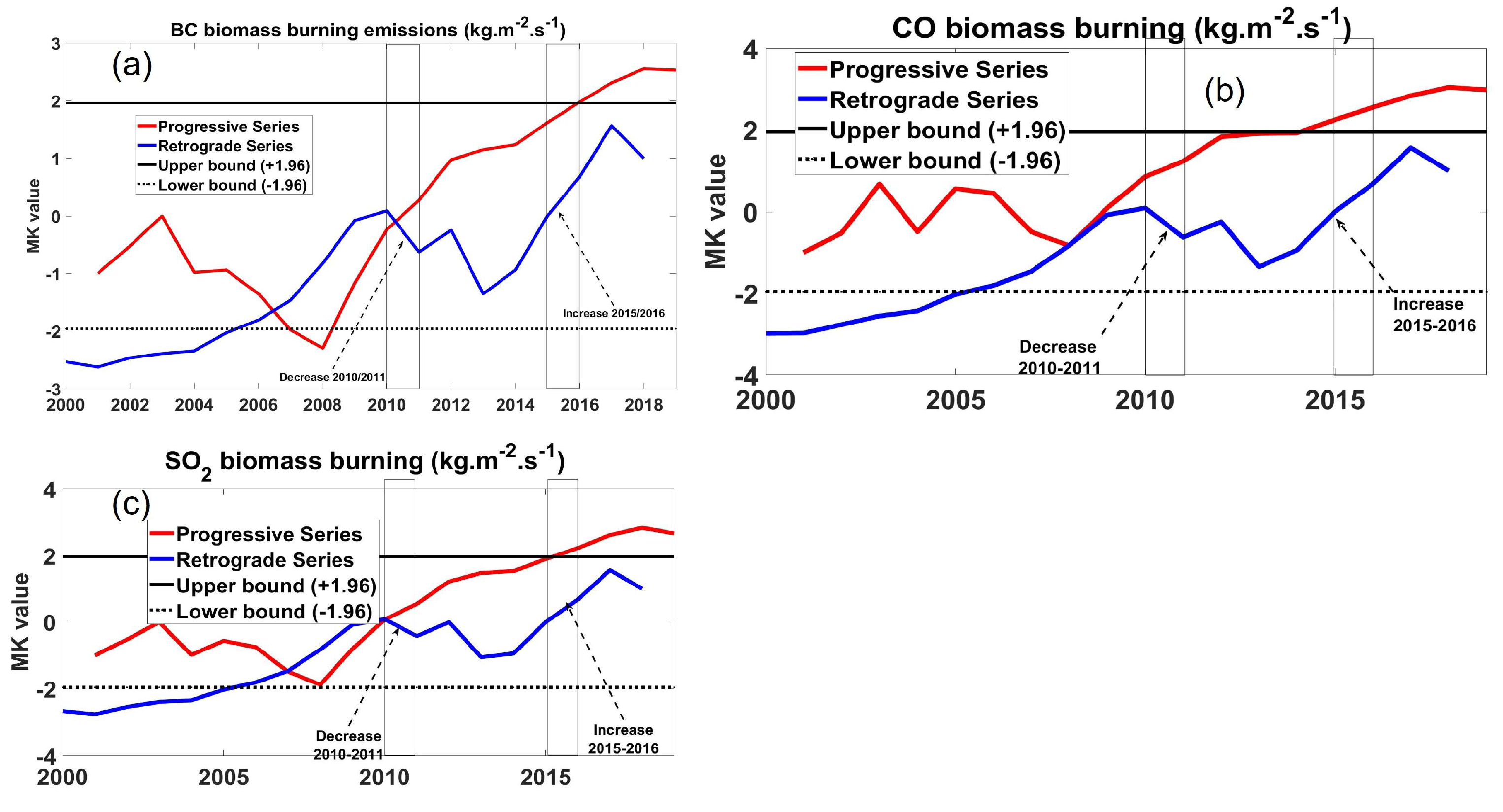

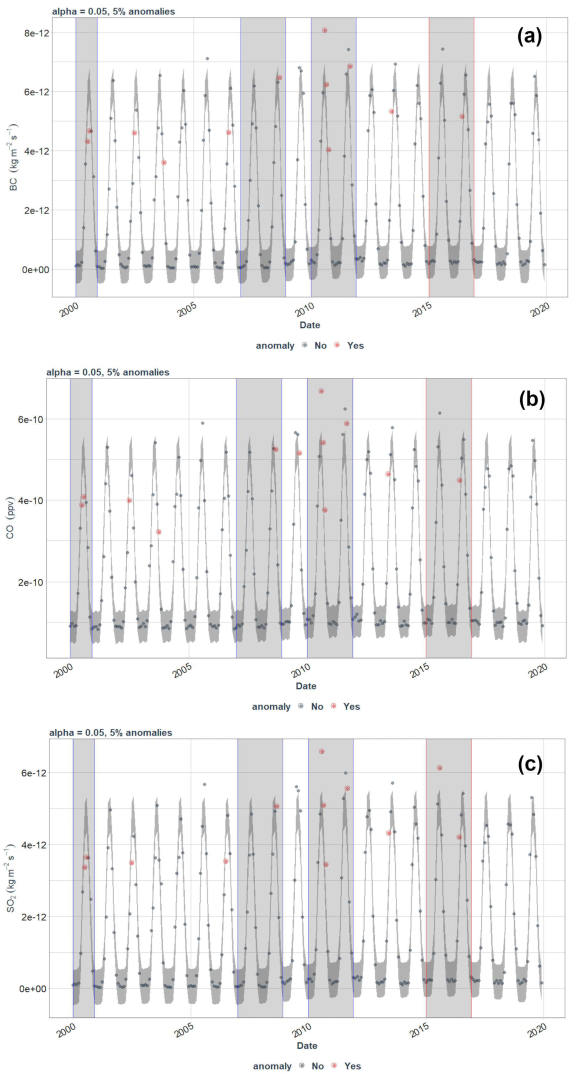
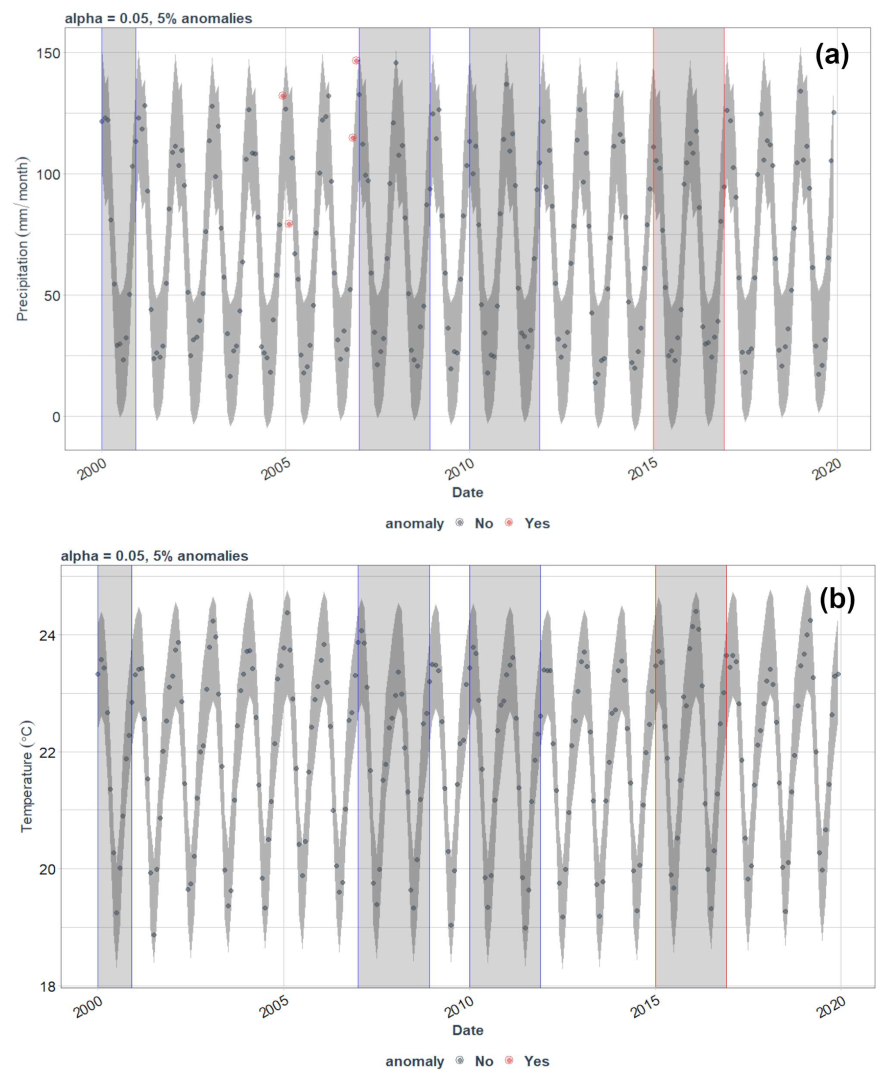
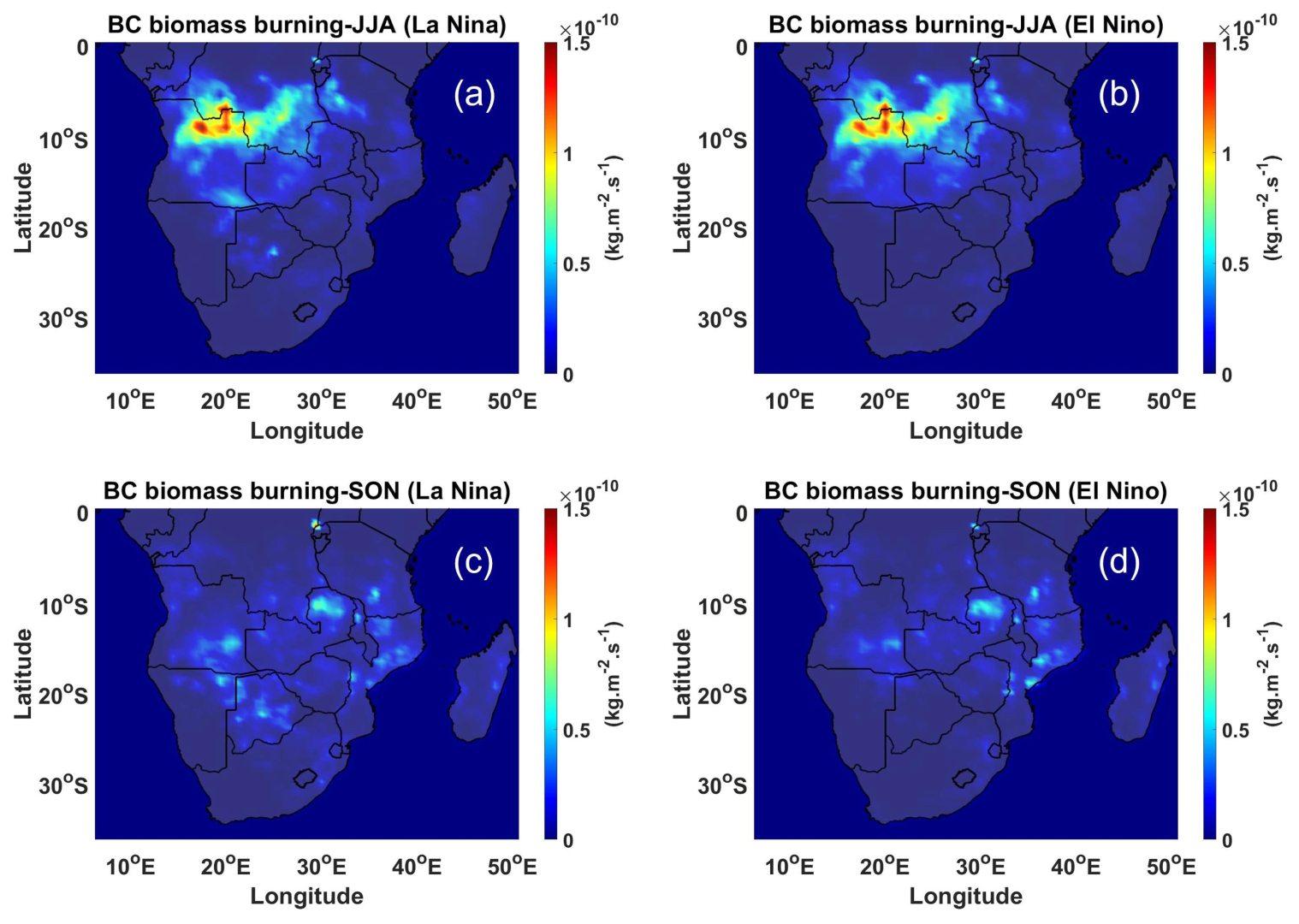
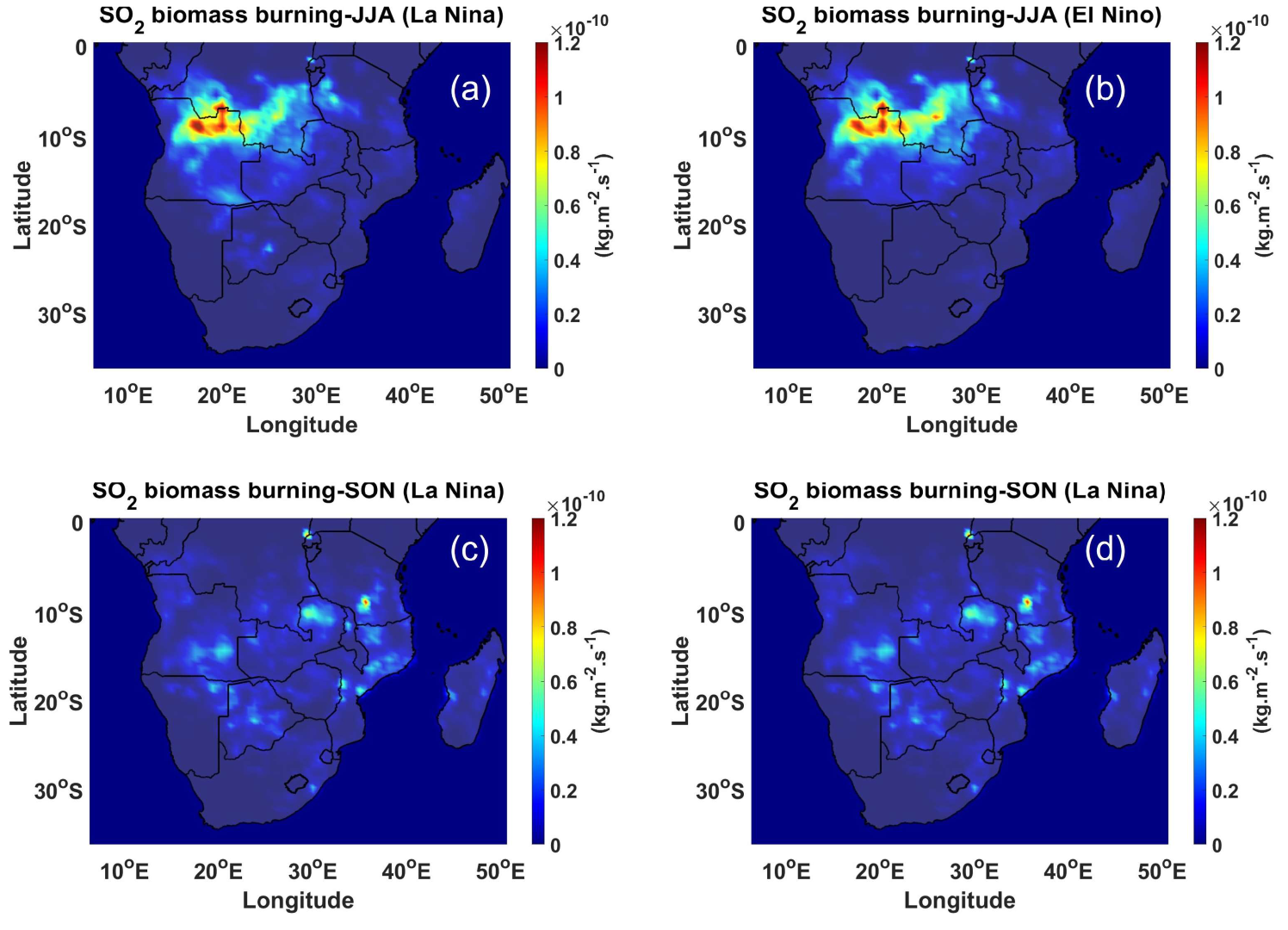

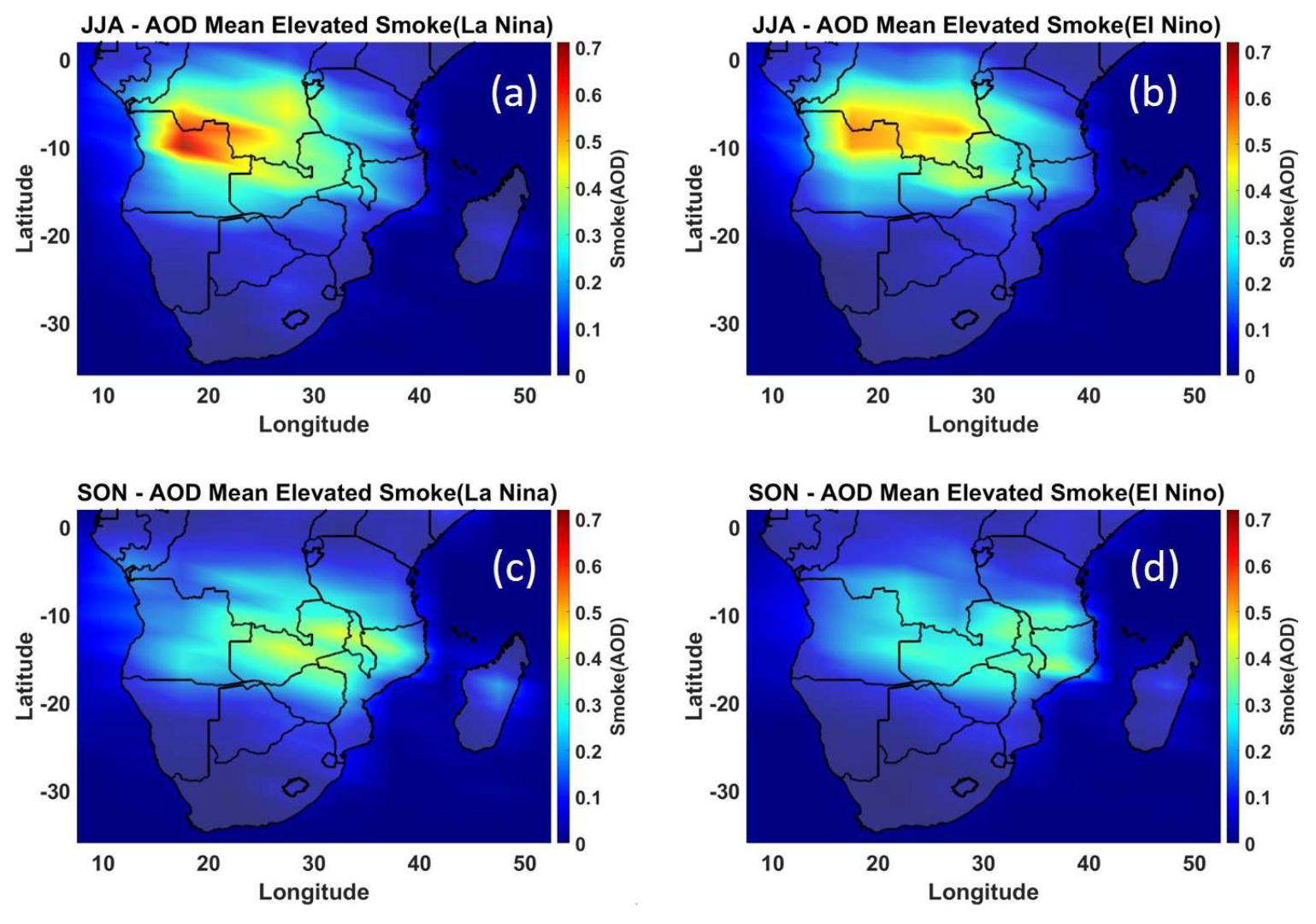

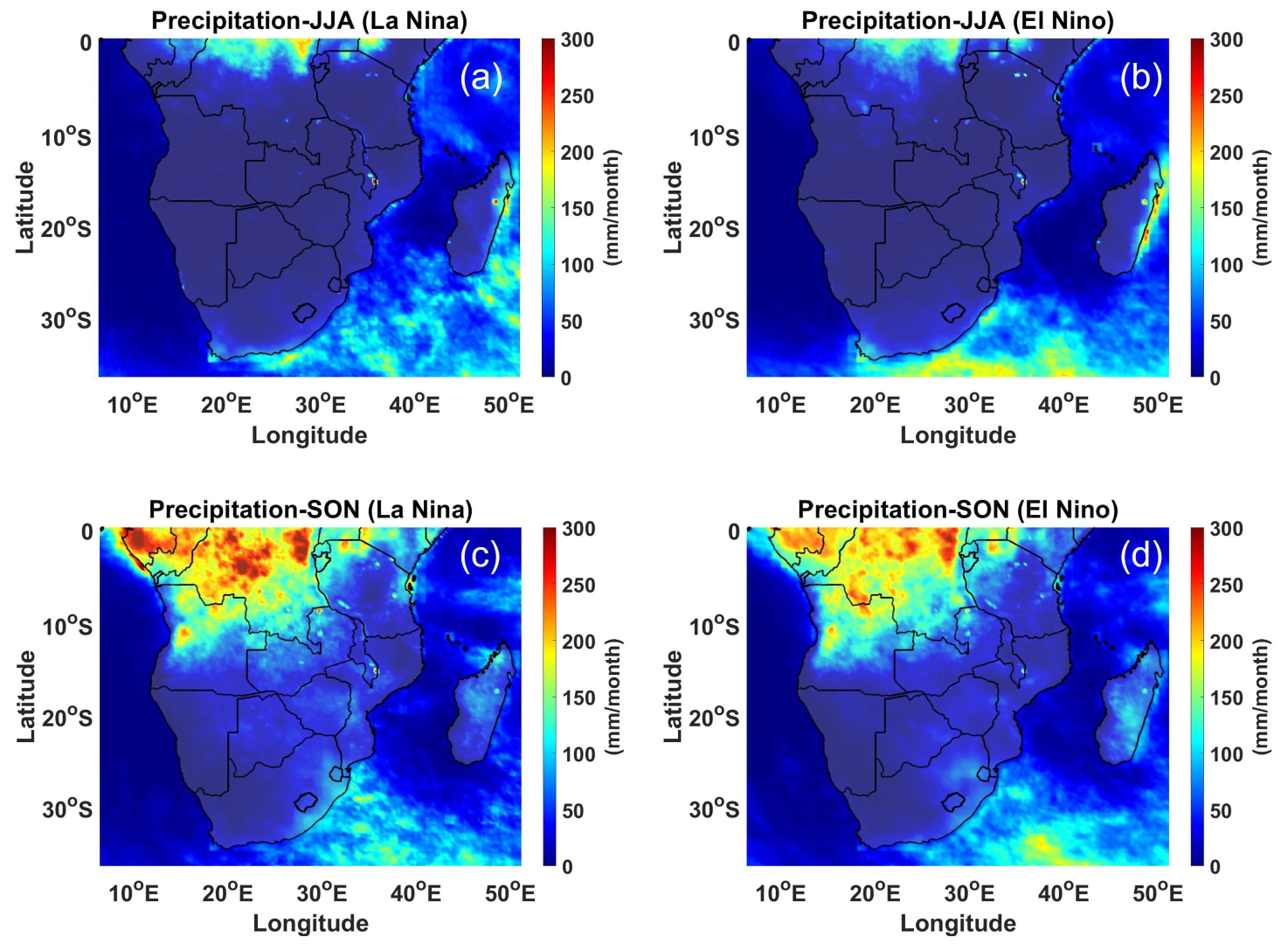
| Input Data Source (Temporal Acquisition, Spatial Resolution) | Products Used | Time of Analysis | Deliverables |
|---|---|---|---|
| The Modern-Era Retrospective Analysis for Research and Applications, Version 2 (Merra-2) (monthly; 0.5° × 0.625°) | (a) CO emissions (kg·m−2·s−1) (b) BC and SO2 biomass-burning emissions (kg·m−2·s−1) | 2010/2011 and 2015/2016 | (a) Spatial distribution maps of CO emissions (b) BC and SO2 distribution maps of biomass-burning emissions |
| Cloud–Aerosol Lidar and Infrared Pathfinder Satellite Observations (CALIPSO) (monthly, 2° × 5°) | (a) AOD mean elevated smoke | 2010/2011 and 2015/2016 | (a) Spatial distribution maps of AOD mean smoke |
| Atmospheric Infrared Sounder (AIRS) (monthly, 13.5 km at nadir, 1 km vertical) | Air temperature (°C) | 2010/2011 and 2015/2016 | Spatial distribution maps of air temperature |
| Tropical Rainfall Measuring Mission (TRMM) (monthly, 0.25° × 0.25°) | Precipitation rate (mm/month) | 2010/2011 and 2015/2016 | Spatial distribution maps of the precipitation rate |
| Parameters | Intersection Points | Remarks | ||
|---|---|---|---|---|
| 1st | 2nd | 3rd | ||
| BC | 2007 | 2011 | ----- | Significant |
| SO2 | 2007 | 2011 | ----- | Significant |
| CO | 2007 | ----- | ------ | Significant |
| Precipitation | 2001 | 2004 | 2007 | -------- |
| Temperature | 2005 | 2012 | 2016 | -------- |
Disclaimer/Publisher’s Note: The statements, opinions and data contained in all publications are solely those of the individual author(s) and contributor(s) and not of MDPI and/or the editor(s). MDPI and/or the editor(s) disclaim responsibility for any injury to people or property resulting from any ideas, methods, instructions or products referred to in the content. |
© 2023 by the authors. Licensee MDPI, Basel, Switzerland. This article is an open access article distributed under the terms and conditions of the Creative Commons Attribution (CC BY) license (https://creativecommons.org/licenses/by/4.0/).
Share and Cite
Shikwambana, L.; Kganyago, M. Seasonal Comparison of the Wildfire Emissions in Southern African Region during the Strong ENSO Events of 2010/11 and 2015/16 Using Trend Analysis and Anomaly Detection. Remote Sens. 2023, 15, 1073. https://doi.org/10.3390/rs15041073
Shikwambana L, Kganyago M. Seasonal Comparison of the Wildfire Emissions in Southern African Region during the Strong ENSO Events of 2010/11 and 2015/16 Using Trend Analysis and Anomaly Detection. Remote Sensing. 2023; 15(4):1073. https://doi.org/10.3390/rs15041073
Chicago/Turabian StyleShikwambana, Lerato, and Mahlatse Kganyago. 2023. "Seasonal Comparison of the Wildfire Emissions in Southern African Region during the Strong ENSO Events of 2010/11 and 2015/16 Using Trend Analysis and Anomaly Detection" Remote Sensing 15, no. 4: 1073. https://doi.org/10.3390/rs15041073
APA StyleShikwambana, L., & Kganyago, M. (2023). Seasonal Comparison of the Wildfire Emissions in Southern African Region during the Strong ENSO Events of 2010/11 and 2015/16 Using Trend Analysis and Anomaly Detection. Remote Sensing, 15(4), 1073. https://doi.org/10.3390/rs15041073







